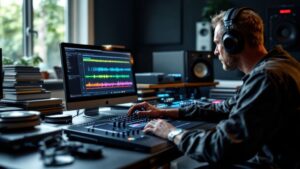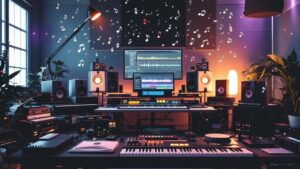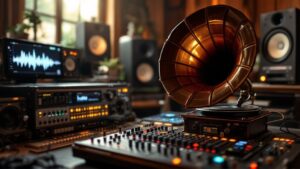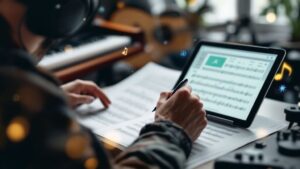Understanding Music Transcription Fundamentals
Converting a musical performance into written notation is no easy task. Music transcription requires careful attention to detail and a strong grasp of musical concepts. Here's what you need to know about this complex but essential musical skill.
Developing Essential Listening Skills
Getting better at transcribing music starts with training your ears. You'll need to pick up on subtle differences in pitch, rhythm, and sound quality – just like how a writer needs to understand language nuances. When transcribing, focus on both individual notes and how they connect within the music. Learning to distinguish between intervals like major and minor thirds helps capture the emotional heart of a piece. Rhythmic elements like swing and syncopation also need special attention. These skills improve gradually through dedicated practice and musical exploration.
Understanding Musical Structures
Having a solid grasp of music theory and structure makes transcription much more manageable. Look for common patterns like chord progressions and melodic phrases, and understand how different sections fit together. For instance, recognizing a standard I-IV-V chord progression lets you anticipate what's coming next. This bigger-picture view shows you how individual notes work together to create the full composition.
The Evolution of Music Transcription
The field of music transcription has come a long way from purely manual methods. A major shift began in 1977 when researchers first introduced the concept of 'automatic music transcription' in academic papers. This groundbreaking work involved converting analog recordings to digital format and using mathematical techniques like Fast Fourier Transforms to identify musical pitches. While basic by today's standards, this research laid the foundation for modern transcription tools. You can learn more about the history of music transcription on Wikipedia's Music Transcription page). Modern transcribers benefit from understanding both traditional methods and new digital approaches to this musical art form.
Mastering Traditional Manual Transcription Methods

While it takes time and practice, manual music transcription remains one of the most valuable skills a musician can develop. This centuries-old practice allows musicians to deeply understand musical compositions by carefully listening and notating what they hear. Let's explore the key techniques that make up effective manual transcription.
Breaking Down Complex Pieces
Think of transcribing music like putting together a puzzle – it's easier when you work piece by piece. Start by focusing on short sections, maybe just a few measures at a time. Listen closely to identify individual notes and rhythms before moving on. For instance, when working on a Bach fugue, you might begin by writing out the main theme as it appears in each voice.
Identifying Harmonies and Rhythms
Once you've isolated sections, your next task is understanding the musical building blocks within them. Work on recognizing the key signature and chord progressions to grasp the harmonic structure. Pay attention to rhythmic elements like syncopation and how different rhythm patterns interact. This step often requires listening to passages multiple times.
Developing an Efficient Workflow
A systematic approach makes manual transcription much more manageable. Many musicians start with the melody line, then add the bass, and finally fill in the inner voices. Having an organized workspace and consistent notation style helps minimize mistakes. This methodical process builds accuracy and speed over time.
Combining Ear Training and Music Theory
Manual transcription works best when you blend practical listening with theoretical knowledge. Your ears tell you what notes you're hearing, while your understanding of music theory helps put those sounds in context. For example, knowing how chords are built helps you predict likely notes, even when they're hard to pick out clearly in the music.
Practical Exercises and Examples
The best way to improve your transcription skills is through regular practice with gradually increasing difficulty. Here are some tips:
- Start with simple melodies before tackling full arrangements
- Try transcribing different musical styles to expand your abilities
- Compare your work to published scores when possible
- Focus on small sections and build up to longer pieces
- Practice identifying common chord progressions and patterns
With dedication and the right approach, you'll develop stronger transcription abilities while gaining deeper musical insights.
Modern Tools for Accurate Music Transcription
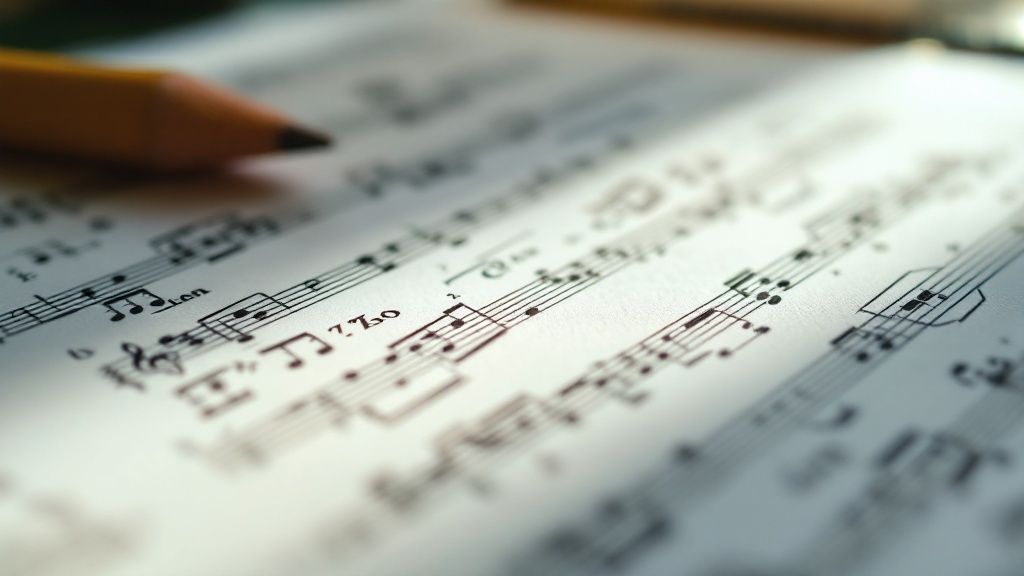
Musicians now have access to excellent tools that make transcribing music easier and more precise. These tools work best when paired with traditional music skills and training. Let's explore how to get the most out of these resources in your transcription work.
Picking Your Software
The right software makes a big difference in music transcription quality. Your choice should match your specific needs and budget. Some programs focus on MIDI transcription for capturing instrumental performances, while others handle polyphonic music with multiple melody lines.
- Match your needs: Different tools work better for piano, orchestra, or jazz. Pick one that fits your music style.
- Compare options: Free tools offer basic features, while paid versions include automatic chord detection and rhythm correction.
- Try before buying: Use trial versions to find what works best for you.
Making Software Work For You
Think of transcription software as a helpful assistant rather than a replacement for your musical expertise. Use it to handle the basic note entry, then apply your knowledge to add expression marks and subtle details that make the music come alive.
Watch Out For Common Issues
While these tools are helpful, they have limits. Don't let software use reduce your listening skills. Some programs struggle with complex chords or unusual instruments. Always check the computer's work against the original recording using your trained ear as the final judge.
How AI Has Changed Music Transcription
Music transcription software improved greatly with AI in the 2000s. These programs now learn from large music collections to become more accurate over time. The software can now handle tasks like multi-note detection and rhythm adjustment that used to be very difficult. This helps musicians work faster and produce better scores. Learn more about automated music transcription's development here. Modern programs can identify complex chords, catch subtle timing changes, and even suggest which instruments to use.
Making the Most of AI Tools for Music Transcription
The rise of AI is reshaping music transcription, giving musicians powerful new tools that can speed up their workflow. While these tools offer significant advantages, knowing both their strengths and weaknesses is key to getting accurate results.
What Today's AI Can Do in Music Transcription
Modern AI transcription software uses deep learning algorithms to turn audio into written music notation. These systems can handle several complex musical elements:
- Multiple Instrument Separation: The AI can often identify and isolate different instruments playing together
- Advanced Chord Recognition: Latest tools can pick up complex harmonies and chord progressions
- Nuanced Rhythm Detection: The software catches subtle timing elements like swing feel and syncopation
One notable feature is the ability to create MIDI files directly from audio. This gives musicians a solid foundation they can then refine and polish.
Current AI Transcription Limitations
While AI tools are impressive, they're not perfect yet. Here are some key limitations:
- Musical Context Understanding: AI may miss the bigger picture of how a piece fits together
- Non-Standard Sounds: The software works best with common instruments and conventional playing styles
- Expressive Details: Subtle elements like dynamics and articulation marks can be overlooked
Audio quality also affects results significantly. Poor recordings or background noise can throw off the AI's note and rhythm detection. This means human musicians still need to review and adjust the computer-generated transcriptions.
Best Ways to Use AI in Your Transcription Process
Here's how to get the most from AI transcription tools:
- Consider AI Output as Draft Material: Use the computer-generated version as a starting point
- Plan Time for Manual Edits: Be prepared to fix errors and add missing musical details
- Apply Your Musical Knowledge: Use your trained ear and theory background to check and improve the AI's work
Recent research shows promising advances in this field. One study found an error rate of just 7.1% and 85.6% accuracy in identifying downbeats when transcribing popular piano music using neural networks and statistical models. Learn more about these developments in this research paper on AI music transcription. By understanding what AI can and can't do well, musicians can use these tools effectively to create accurate, expressive scores.
Real-World Applications That Drive Results

Music transcription opens doors to exciting professional opportunities in the music industry. Musicians and educators regularly use transcription skills across many musical styles and contexts. Whether you're working with improvised jazz solos or intricate classical pieces, strong transcription abilities help you excel in different genres.
Transcription in Diverse Musical Contexts
Music education relies heavily on transcription to help students develop their ear training and notation abilities. Professional performers and composers also use transcription regularly in their work. For musicians, carefully studying guitar solos or orchestral movements through transcription reveals important musical concepts that improve their craft.
- Jazz Improvisation: Writing down solos helps musicians understand and recreate complex improvisational passages
- Classical Music: Breaking large orchestral works into individual parts makes learning challenging pieces more manageable
Industry Utilization of Transcription Services
Many music industry sectors depend on quality transcription work. For example, entertainment companies use transcription to organize their music libraries and analyze performances. This process allows musicians to spot unique interpretive choices and compare different versions of pieces.
Fact: Automatic music transcription serves both academic research and commercial needs. Common applications include studying musical works and creating sheet music for recordings that lack written scores, making music more accessible. Learn more about transcription's role in music research and industry.
Specific Scenarios Requiring Precise Transcription
Film scoring demands extremely accurate transcription to properly match music with on-screen action and emotion. Video game composers also rely on detailed transcriptions as reference points to ensure music fits seamlessly with gameplay.
- Film and Gaming: Careful transcription maintains consistency across soundtracks and supports the overall story
- Sonic Branding: Companies use transcription to protect and reproduce their unique audio identities
Understanding these practical applications helps musicians and teachers use transcription skills effectively across different music careers. As we explore further, you'll see how working through transcription challenges can strengthen your musical abilities.
Overcoming Common Transcription Challenges
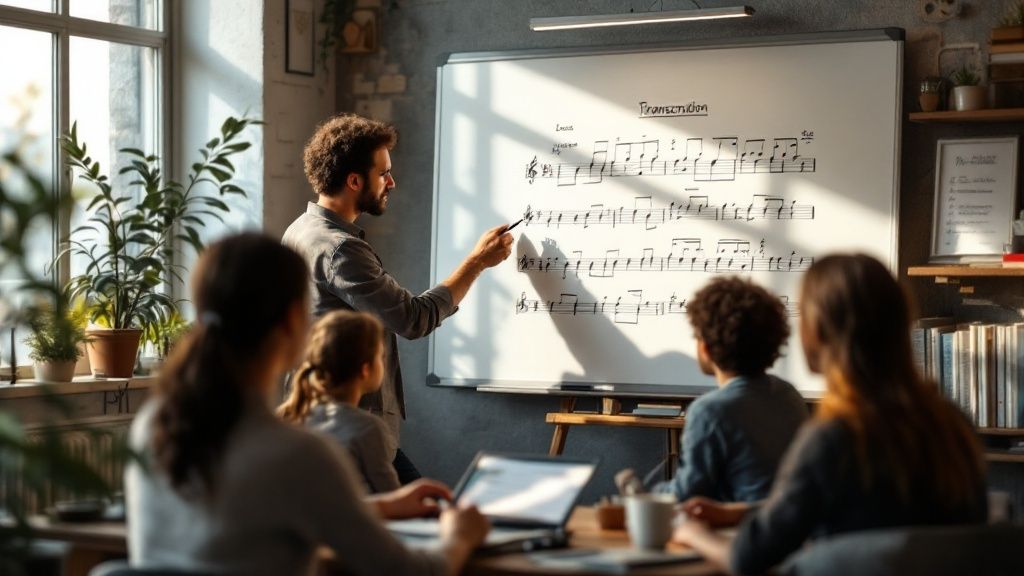
Transcribing music takes skill and practice. While having solid fundamentals helps, you'll still encounter tricky passages that test your abilities. Let's explore practical ways to handle common challenges and build your transcription skills.
Handling Complex Rhythmic Patterns
When facing intricate rhythms like polyrhythms or syncopation, break them down into smaller segments you can manage. Try this simple approach:
- Tap your foot to keep the main beat
- Clap or sing the rhythm you're working on
- Slow down the recording to catch subtle timing details
This method helps you isolate and understand complex rhythmic elements piece by piece.
Deciphering Dense Harmonies
Rich harmonies with multiple voices can be overwhelming at first. The key is to focus on one part at a time:
- Start with the main melody
- Add supporting voices one by one
- Use your knowledge of common chord progressions as a guide
- Listen for familiar chord shapes and inversions
This systematic approach makes dense harmonic passages more manageable.
Navigating Intricate Musical Textures
Orchestra pieces and complex arrangements need an organized strategy. Here's a proven method:
- Identify the primary melody and rhythm first
- Add supporting voices systematically
- Work through one section at a time
- Use different colors to mark different instruments/parts
- Keep your score clean and readable
This structured process helps you build accurate transcriptions layer by layer.
Troubleshooting and Verification Techniques
Always check your work carefully against the original recording. Some key tips:
- Play back what you've written to catch discrepancies
- Compare your work with other transcriptions when available
- Connect with other musicians to discuss challenging sections
- Join online music communities to share tips and get feedback
Remember that even experienced transcribers face difficulties. The key is developing your ear and working systematically. Regular practice and learning from others will help you create more accurate transcriptions over time.




